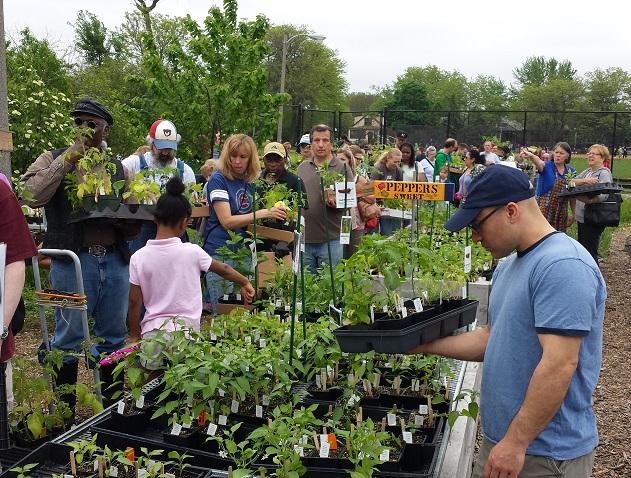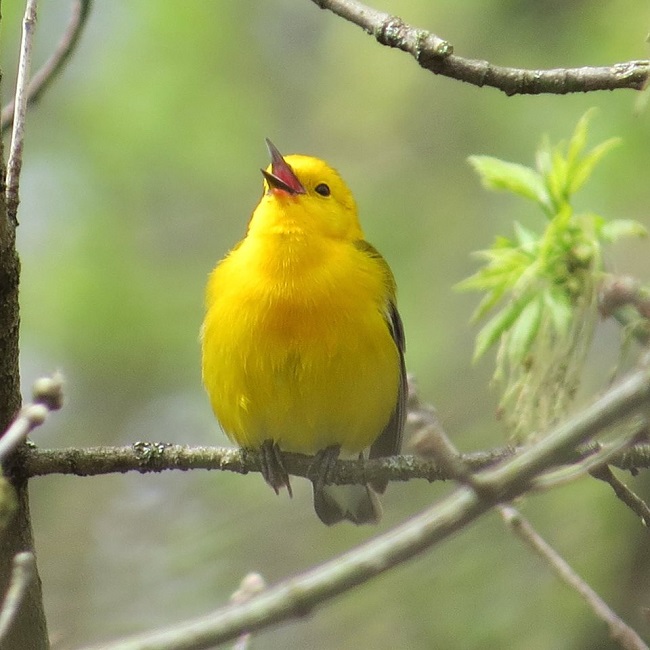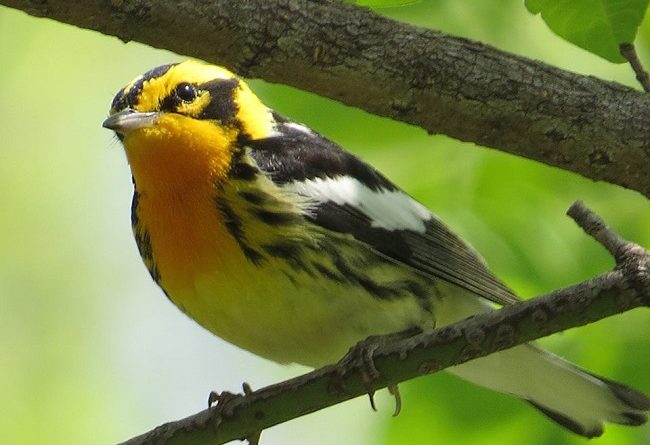May 13, 2018 – Year of the Bird
On Mother’s Day weekend, gardening starts in earnest around here.
![]() (Blackburnian Warbler photo by Jeff Skrentny) Of course, that doesn’t mean that conditions are perfect yet. Just this week, I got involved in a discussion on a Facebook gardening site about whether it was safe to put tomatoes in the ground. The high temperature that day was 82 °F, the low was 70 °F, and the ten-day forecast was looking pretty good. A lot of local gardeners were chirping about how their tomatoes were already in the ground. Ladies and gentlemen, start yer engines!
(Blackburnian Warbler photo by Jeff Skrentny) Of course, that doesn’t mean that conditions are perfect yet. Just this week, I got involved in a discussion on a Facebook gardening site about whether it was safe to put tomatoes in the ground. The high temperature that day was 82 °F, the low was 70 °F, and the ten-day forecast was looking pretty good. A lot of local gardeners were chirping about how their tomatoes were already in the ground. Ladies and gentlemen, start yer engines!
Three days later, the high temp was 52 °F, and the low was 46 °F.
How’s that early start for tomatoes workin’ out for ya?
Such are the dangers of setting your gardening chores to specific dates, at least in parts of the world where there are distinct seasons. Even if you go by soil temperatures, it’s pretty cold in parts of the Midwest right now. As I was writing this blog post, I walked out to my backyard and took a sample soil temp–55 °F. That’s pretty much the minimum temperature for even considering transplanting a tomato seedling.
The lesson is that, in certain parts of the country, it’s necessary for gardeners to keep an eye on the weather forecast, not the calendar.
That said, there are some dates that should be circled on your calendars. No offense, mom, I’m not talking about you. I’m referring to the annual Kilbourn Park Organic Plant Sale on Chicago’s northwest side:
 Kilbourn Park Organic Greenhouse will offer more than 150 varieties of organically-grown vegetable, herb, and flower seedlings. Customers can expect a wide variety of open-pollinated and heirloom tomatoes, peppers, and eggplants. Other highlights include an assortment of herbs, greens and onions. This year will feature many new plants selected for city gardening in small spaces and containers. These seedlings are grown with the support of a team of dedicated volunteers who make this Plant Sale possible. Volunteers will be on hand to answer questions about plant selection and planting. This yearly fundraiser supports the greenhouse and our work to connect kids to nature and healthy foods.
Kilbourn Park Organic Greenhouse will offer more than 150 varieties of organically-grown vegetable, herb, and flower seedlings. Customers can expect a wide variety of open-pollinated and heirloom tomatoes, peppers, and eggplants. Other highlights include an assortment of herbs, greens and onions. This year will feature many new plants selected for city gardening in small spaces and containers. These seedlings are grown with the support of a team of dedicated volunteers who make this Plant Sale possible. Volunteers will be on hand to answer questions about plant selection and planting. This yearly fundraiser supports the greenhouse and our work to connect kids to nature and healthy foods.
You get two cracks at this, on Saturday and Sunday, May 19 & 20 from 10:00 AM to 2:00 PM at Kilbourn Park, 3501 N. Kilbourn Avenue, Chicago, IL 60641. I’ve been there several times, and it’s a pretty big deal…meaning that it gets crowded and you’d better get there early for best selection. In addition to the organically-grown veggies, there will be other plants donated by volunteers of the Kilbourn Park Organic Greenhouse, organic compost, light snacks, and even a cookbook compiled by the Friends of Kilbourn Park Organic Greenhouse, which is available for purchase.
Plants include broccoli, cabbage, cauliflower, cucumber, eggplant, fennel, leeks, lettuce, melons, onions, peppers, squash, Swiss chard, tomatoes and more. In fact, the sale generally has 6,000 or more seedlings for sale.
You can find the entire list here.
Peggy and I are pleased to welcome Renee Costanzo, Kilbourn Park’s Program Specialist in the Organic Greenhouse, and Lourdes Valenzuela, a retired Chicago Public School teacher who is now a volunteer with Friends of Kilbourn Park Organic Greenhouse. If you have questions about getting your vegetable or perennial garden started this year, give us a call at 877-711-5611.
Celebrating International Migratory Bird Day at LaBagh Woods
2018 marks the one hundred years of perhaps the most important environmental law ever passed on this planet. In 1918, following the extirpation of several species of bird, including the passenger pigeon, the Migratory Bird Treaty Act, which codified a treaty already signed with Canada (then part of Great Britain), was passed by Congress. According to National Audubon Society,
The law prohibits killing or harming America’s birds except under certain conditions, including managed hunting seasons for game species. The law protects more than 1,000 bird species in part because it requires industries implement commonsense best management practices like covering tar pits and marking transmission lines.
Over ten decades, with the signing on of more countries and with the addition of numerous bird species, it’s possible that the law and treaty have saved billions of birds from destruction.
But there’s a dark irony to the centennial year of this iconic law. It is now being weakened by the Trump Administration.
In an opinion issued Wednesday to federal wildlife police who enforce the rule, the Interior Department said “the take [killing] of birds resulting from an activity is not prohibited by the Migratory Bird Treaty Act when the underlying purpose of that activity is not to take birds.” For example, the guidance said, a person who destroys a structure such as a barn knowing that it is full of baby owls in nests is not liable for killing them. “All that is relevant is that the landowner undertook an action that did not have the killing of barn owls as its purpose,” the opinion said.
If that horrifies you, at least you still have a beating heart and a conscience. The same cannot be said for our current administration.

Regardless, 2018 has been designated Year of the Bird, and next Saturday, May 19, International Migratory Bird Day (IMBD) will be celebrated from 9 a.m. to 11:30 a.m. at LaBagh Woods, 5400 N Cicero Ave. in Chicago, part of the Forest Preserve District of Cook County. Visit with a live owl or hawk. Tour a bird-focused habitat restoration and plant a shrub. Listen to the songs of a local chorus, the Bullfrogs. Enjoy crafts, snacks, bird walks and more. Attendees can enjoy seeing a variety of birds migrating from Central America, South America and the Caribbean.
Joining us in studio today to discuss the event and state of bird populations, are bird conservationist Judy Pollock of Judy Pollock Consulting, and Jeff Skrentny, a member of the Chicago Ornithological Society, who created the Facebook group My Years Birding at LaBagh Woods.
Meanwhile, Peggy Malecki, who is a birder herself, has alerted me to this story from Mother Nature Network:
Just in time for the spring migration, Cornell scientists have launched a new tool on their BirdCast website that shows in near real-time the volume and direction of migratory birds traveling throughout the country. The new migration forecast maps will keep you apprised of what to expect in the days (and nights) ahead.


